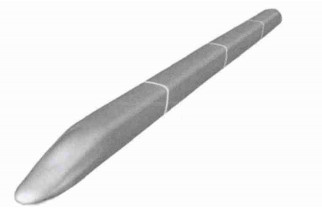-
摘要: 采用基于有限体积方法的计算流体力学软件, 建立了列车几何模型和非定常可压缩湍流的三维流动模型, 对高速列车隧道内等速和不等速交会的全过程进行了数值模拟。在软件的任意滑移界面动网格技术中嵌入了列车光滑启动方法, 研究了列车交会过程中隧道断面的压力波动、流速变化和压力波的形成过程。研究结果表明: 基于三维流动模型的计算结果能够清晰地展示高速列车隧道内交会时的压力场与速度场变化情况, 同一隧道横截面上各点的压力波动趋势与断面压力均值的波动趋势虽然一致, 但不同测点的压力差异较大, 最大可达53.5%;等速交会时隧道中央的交会压力变化幅值最大, 负压峰值达到约-7kPa; 不等速交会时高速列车车体正压峰值与负压峰值均随低速列车速度的减小而减小, 而低速列车比高速列车的正压峰值大约1.5kPa; 两列车鼻尖交会处的隧道断面压力波负压峰值与低速列车速度的二次方近似成正比。Abstract: The geometric model of train and 3Dunsteady-compressible turbulence model were set up by using the computational fluid dynamics(CFD)software based on the finite volume method(FVM), and the whole crossing processes of high-speed trains were simulated in constant-speed and variable-speed conditions.The smooth starting method was coupled into the moving mesh technique of arbitrary sliding interface(ASI)to study the pressure fluctuation characteristics, the air velocity varition and the forming processes of pressure waves at tunnel sections in the whole crossing processes.Study result shows that the pressure fields and velocity fields in high-speed trains passing process in tunnel are clearly depicted via the 3Dfluid flow model.Though the pressure fluctuation trends of monitoring points at a tunnel cross section are consistent with that of cross-section average pressure, the pressure differences of monitoring points are considerably high, and the maximal difference is 53.5%.The pressure fluctuation amplitude at the middle section of tunnel is largest in constant-speed crossing, and the negative pressure peak value is about-7kPa.In constant-speed crossing, when the speed of lower-speed train decreases, the peak values of positive and negative pressures for higher-speed train decrease, while the positive pressure peak value of lower-speed train is about 1.5kPa higher than that of higher-speed train.The negative pressure peak value at the cross section where two train noses meet together isproximately direct proportional to the speed square of lower-speed train.
-
Key words:
- high-speed trains /
- tunnel /
- crossing pressure wave /
- aerodynamic loads /
- numerical simulation
-
表 1 拟合结果
Table 1. Fitting result

-
[1] 田红旗. 列车交会空气压力波研究及应用[J]. 铁道科学与工程学报, 2004, 1(1): 83-89. doi: 10.3969/j.issn.1672-7029.2004.01.015TIAN Hong-qi. Research and applications of air pressure pulse from trains passing each other[J]. Journal of Railway Science and Engineering, 2004, 1(1): 83-89. (in Chinese) doi: 10.3969/j.issn.1672-7029.2004.01.015 [2] 李人宪, 关永久. 高速列车隧道会车压力波动问题[J]. 机械工程学报, 2012, 48(20): 127-134. https://www.cnki.com.cn/Article/CJFDTOTAL-JXXB201220025.htmLI Ren-xian, GUAN Yong-jiu. Investigation of air pressure pulse when two high-speed trains passing by each other in tunnel[J]. Journal of Mechanical Engineering, 2012, 48(20): 127-134. (in Chinese) https://www.cnki.com.cn/Article/CJFDTOTAL-JXXB201220025.htm [3] FUJII K, OGAWA T. Aerodynamics of high speed trains passing by each other[J]. Computers and Fluids, 1995, 24(8): 897-908. doi: 10.1016/0045-7930(95)00024-7 [4] 王建宇, 万晓燕, 吴剑. 高速铁路隧道内瞬变气压和乘车舒适度准则[J]. 现代隧道技术, 2008, 45(2): 1-5, 10. doi: 10.3969/j.issn.1009-6582.2008.02.001WANG Jian-yu, WAN Xiao-yan, WU Jian. Air pressure transient in high speed railway tunnels and passenger comfort criteria[J]. Modern Tunnelling Technology, 2008, 45(2): 1-5, 10. (in Chinese) doi: 10.3969/j.issn.1009-6582.2008.02.001 [5] 梅元贵, 余南阳, 赵海恒, 等. 高速列车隧道会车压力波的数值分析方法[J]. 铁道学报, 2002, 24(2): 21-25. doi: 10.3321/j.issn:1001-8360.2002.02.005MEI Yuan-gui, YU Nan-yang, ZHAO Hai-heng, et al. Numerical method on transient pressure with high speed trains crossing through a tunnel[J]. Journal of the China Railway Society, 2002, 24(2): 21-25. (in Chinese) doi: 10.3321/j.issn:1001-8360.2002.02.005 [6] 马伟斌, 张千里, 刘艳青. 中国高速铁路隧道气动效应研究进展[J]. 交通运输工程学报, 2012, 12(4): 25-32. doi: 10.3969/j.issn.1671-1637.2012.04.004MA Wei-bin, ZHANG Qian-li, LIU Yan-qing. Study evolvement of high-speed railway tunnel aerodynamic effect in China[J]. Journal of Traffic and Transportation Engineering, 2012, 12(4): 25-32. (in Chinese) doi: 10.3969/j.issn.1671-1637.2012.04.004 [7] TRIEBSTEIN H. Transient pressure measurements at the top of the engine 103 during the passage through the Heitersberg tunnel[C]∥STEPHENS H S, WOOD P A. Proceedings of the Third International Symposium on the Aerodynamics and Ventilation of Vehicle Tunnels. Cranfield: BHRA Fluid Engineering, 1979: 303-324. [8] KOMATSU N, YAMADA F, MINAMI T. The reduction of disturbance of the train draft pressure in passing by each other[C]∥Railway Technical Research Institute. The Fourth World Congress on Railway Research. Tokyo: Railway Technical Research Institute, 1999: 1-7. [9] MANCINI G, MALFATTI A. Full scale measurements on high speed train ETR500 passing in open air and in tunnels of Italian high speed line[C]∥SCHULTE-WERNING B, GREGOIRE R, MALFATTI A, et al. A European Initiative on Transient Aerodynamics for Railway System Optimization. Berlin: Springer, 2002: 101-122. [10] MATSCHKE G, HEINE C. Full scale tests on pressure wave effects in tunnel[C]∥SCHULTE-WERNING B, GREGOIRE R, MALFATTI A, et al. A European Initiative on Transient Aerodynamics for Railway System Optimization. Berlin: Springer, 2002: 187-195. [11] 马伟斌, 俞翰斌, 付连著, 等. 某特长水下隧道气动效应试验研究[J]. 中国铁道科学, 2012, 33(1): 41-46. doi: 10.3969/j.issn.1001-4632.2012.01.07MA Wei-bin, YU Han-bin, FU Lian-zhu, et al. Experimental research on the aerodynamics effect of an extra-long underwater tunnel[J]. China Rialway Science, 2012, 33(1): 41-46. (in Chinese) doi: 10.3969/j.issn.1001-4632.2012.01.07 [12] 梅元贵, 余南阳. 高速列车隧道会车压力波的数值模拟[J]. 兰州铁道学院学报, 1998, 17(4): 49-53. https://www.cnki.com.cn/Article/CJFDTOTAL-LZTX804.010.htmMEI Yuan-gui, YU Nan-yang. Numerical simulation of high-speed trains induced pressure waves in a single bore tunnel[J]. Journal of Lanzhou Railway Institute, 1998, 17(4): 48-53. (in Chinese) https://www.cnki.com.cn/Article/CJFDTOTAL-LZTX804.010.htm [13] 李志伟, 梁习锋, 周丹. 快速集装箱平车在明线和隧道内会车时的气动性能[J]. 中南大学学报: 自然科学版, 2008, 39(5): 1029-1034. https://www.cnki.com.cn/Article/CJFDTOTAL-ZNGD200805029.htmLI Zhi-wei, LIANG Xi-feng, ZHOU Dan. Aerodynamic performance for container flat wagon passing in open air and in tunnel[J]. Journal of Central South University: Science and Technology, 2008, 39(5): 1029-1034. (in Chinese) https://www.cnki.com.cn/Article/CJFDTOTAL-ZNGD200805029.htm [14] 田红旗. 中国列车空气动力学研究进展[J]. 交通运输工程学报, 2006, 6(1): 1-9. doi: 10.3321/j.issn:1671-1637.2006.01.001TIAN Hong-qi. Study evolvement of train aerodynamics in China[J]. Journal of Traffic and Transportation Engineering, 2006, 6(1): 1-9. (in Chinese) doi: 10.3321/j.issn:1671-1637.2006.01.001 [15] CHUNG M H. A level set approach for computing solutions to inviscid compressible flow with moving solid boundary using fixed Cartesian grids[J]. International Journal for Numerical Methods in Fluids, 2001, 36: 373-389. doi: 10.1002/fld.32 [16] LIU J L. Computations of two passing-by high-speed trains by a relaxation overset-grid algorithm[J]. International Journal for Numerical Methods in Fluids, 2004, 44: 1299-1315. doi: 10.1002/fld.631 [17] IIDA M, FUKUDA T, KIKUCHI K. Numerical analysis of the pressure wave radiated from the entrance when a train enters a tunnel[J]. Transaction of the Japan Society of Mechanical Engineers, 2000, 66(651): 2861-2868. doi: 10.1299/kikaib.66.651_2861 [18] MEI Yuan-gui. A generalized numerical simulation method for pressure waves generated by high-speed trains passing through tunnels[J]. Advances in Structural Engineering, 2013, 16(8): 1427-1436. doi: 10.1260/1369-4332.16.8.1427 [19] RAGHUNATHAN R S, KIM H D, SETOGUCHI T. Aerodynamics of high-speed railway train[J]. Progress in Aerospace Sciences, 2002, 38(6/7): 469-514. -





 下载:
下载:


























